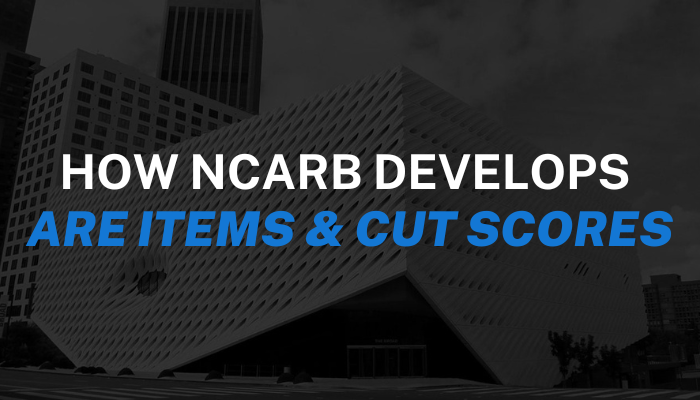How NCARB Develops ARE Items and Cut Scores
Have you encountered a question on the ARE that really stumped you? Maybe you were familiar with the topic, but weren't sure what the question was asking or how to determine the correct answer. Did you know that NCARB follows an extensive process for developing each item, or question, that you see on the ARE? Getting into the mindset of the question writers will help you dissect those tricky questions so you will know how to approach them on exam day.
Developing ARE Items
First, NCARB conducts a practice analysis with architects and other industry stakeholders to determine what a competent, independently practicing architect needs to know. This is how the six divisions of the ARE 5.0 (Practice Management, Project Management, Programming & Analysis, Project Planning & Design, Project Development & Documentation, and Construction & Evaluation) were established. These six divisions make up six separate exams, which are further broken down into content areas and specific objectives for each division, as outlined in the ARE 5.0 Guidelines.
A team of writers, composed of volunteer architects, psychometricians, NCARB staff, and even ARE candidates, begin to create ARE items. Their real-world experiences contribute to scenarios used to develop these items. New items are reviewed by an experienced, item-writing mentor, who then submits the item to a professional editor after necessary revisions are completed. The item is then reviewed by the Item Development and Case Study Subcommittee, adjusted as needed, and either declared “ready for use” or “faulty.”
Once NCARB confirms that an item is ready for use, it goes through the “pretesting” process - it is added to the ARE as an unscored question so that it can be monitored and confirmed as a fair and reliable item. Each division has a specific number of pretest items randomly sprinkled throughout and candidates do not know which ones they are; so, if you’re really stumped on a single question and don’t know how to approach it, there is a chance it could be a pretest item and will not count towards or against your final score. If the item does not raise any concerns and is deemed ready for operational status, it then becomes a live, scored item on the ARE.
NCARB continuously monitors the performance of ARE items to ensure that they meet the standards set forth in the first step of this process. If an item is no longer relevant or appropriate, it will be retired from the ARE.
At Black Spectacles, we strive to create practice questions that will closely align with what you will see on the ARE. This is why we follow the same, rigorous process in creating practice questions amongst our own team of subject matter experts and learning designers.
Compiling Exam Forms
To ensure that a candidate will not encounter the same questions when retaking an exam, NCARB compiles multiple exam forms for each division. Similar to the process for developing items, NCARB follows a strategic process for compiling exam forms. This is to ensure that each unique form follows the same structure (testing and break times, content and item type distribution, number of items, etc.) while maintaining consistent rigor (difficulty, variance of scores, etc.).
NCARB limits a candidate to attempting the same division three times in a 12-month period so that they will not have a repeated exam form during this timeframe.
By offering three unique practice exam forms for each division, Black Spectacles provides you with the opportunity to simulate the ARE experience of encountering unfamiliar questions and putting your knowledge to the true test. We also have a fourth, random, form for each division that you can use to brush up on questions you’ve already answered.
Establishing Cut Scores
The ARE is designed to assess a candidate’s competency in protecting the public’s health, safety, and welfare as an architect. Because each of the six divisions of the ARE cover different content areas with varying levels of difficulty, performance expectations also vary from division to division (and form to form).
It is important to remember that you don’t need to score 100% in order to pass the exams. NCARB establishes a specific cut score range for passing, which varies from 58-71% depending on the division.
Strategize to pass each exam, rather than aim for a perfect score. You can do this by mastering the overarching concepts for each division, with help from the Guided Study Process.
Don’t waste time studying topics that may account for maybe one or two questions on the actual exam, if that. Use our quizzes and practice exams to apply your knowledge to the exam format, but don’t just try to score 100%. Focus on deeply understanding the content, rather than memorizing answers. Practice taking educated guesses, and work on using the process of elimination to at least give yourself a better chance of getting questions right.
Check out our tips on how to approach each item type on the ARE 5.0.
This is how NCARB develops ARE items and cut scores. Learn more about Black Spectacles ARE 5.0 exam prep here.
